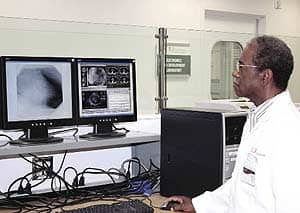
Jeff Kabachinski
5010, D.0, 3.0, Hike? Wait a minute. It’s too early for football season—what gives? These numbers must refer to something else. Seriously, if you do not recognize these shorthand quasi-acronyms, you have got some catching up to do! In brief, they are the new HIPAA electronic transaction code standards adopted by the US Department of Health and Human Services (HHS). This massive update is getting added attention now as the compliance deadline looms closer. This is just one on the list of good reasons for BMETs and CEs to stay tuned to this one. It is generally a good idea to be aware of what is impacting your business and employer, but as we will see, this also offers an opportunity to future-proof employment! This month, we take a look at what the new HIPAA law entails and what it means for BMETs and CEs.
Bottom Line
This large update directly affects how a hospital does business and therefore affects the entire organization. HIMSS warns that business operations, workflow, and many daily business transactions will change to accommodate the standard. Medicare has effectively locked down the go-live compliance deadline of January 1, 2012. Consider that Medicare accounts for the lion’s share of many hospitals’ patient care revenue and that it will operate exclusively in accordance with the new standards, which influences the industry to follow suit.
While the update is long overdue and brings many needed improvements, it is stacking up to be a long and painful process. A recent HIMSS health care IT readiness survey indicated that IT staffs worry that not everyone will be ready in time. This includes software vendors that supply compliant business applications, clearinghouses ready to accept new codes, and payors ready to pay claims. They will all be ready, but it remains unclear whether all these stakeholders will be ready and in sync with enough time for total system testing, tweaking, and revising, to be fully operational before the due date. I can just hear the voice of Dustin Hoffman in Rain Man continually saying, “Uh-oh,” as he paces back and forth—or was that the IT director?
It’s a Big Deal

Health care IT staff have been talking about the tremendous amount of extra work involved in complying—especially in light of everything else that is going on (EHR and Meaningful Use, IEC 80001-1 Risk Assessment, and MDDS FDA compliance, to name a few). Good grief! We might as well switch everyone’s PC to a Mac while we’re at it! To get an idea of the relative size of the updates, consider that there will be 1,200 new clinical category codes to deal with, more than 100,000 newly added clinical codes, and more than 190,000 added procedural codes. Currently, there are just 17,000 total clinical and procedure codes.
I don’t mean to paint too gray of a picture, as there are a lot of good reasons for the updates. In addition to modernizing to get current with technology and the requirements of new and better health care practices, there are many not-so-obvious benefits. A few examples: The update includes support of emerging data requirements of things like bioterrorism and public health reporting. There will be improved and more granular data reporting and accuracy for quality and patient safety, in addition to improved data accuracy for claim processing.
Mixed Signals
Pay attention! This update will affect a lot of people. Clear and consistent communication in a widespread complex situation like this is key for success. A confusing aspect to all of this is the acronyms, nicknames, and jargon we constantly invent and use. Slightly different names for the standards, like ASC X12 version 5010, and NCPDP versions D.0 and 3.0, are commonly used. (Note: the regulation is 45 CFR Part 162–CMS-0009-P.) If we can disambiguate the terminology and jargon, it will help to gain perspective of the impact. Most of the time, jargon speeds up and clarifies communication, especially for those hip to the jive. We are hardly aware of the extent we abbrev! What is clear to you may not be clear to others. Be careful. If you blink, you might miss a new one sneaking into the lexicon—like the popular “disambiguation.” It is not only the correct definition of words, but also the order you use them. You do not want to suffer from Darmok and Jalad at Tenagra communication disorder (from Star Trek: The Next Generation).
A Little Background
Many things have changed since the current version of the HIPAA standard was published in 2000—ancient history in technological terms. The governing body for the HIPAA transaction standards is the Accredited Standards Committee X12 (ASC X12; www.x12.org). It has tracked more than 500 change requests to improve and expand the version 5010 standard’s usefulness. The American National Standards Institute (ANSI) chartered ACS X12 in 1979 to develop electronic data interchange (EDI) standards. ASC X12 has grown to more than 3,000 industry experts and more than 300 diverse companies to develop the standards and maintain the 315 widely adopted published standards.
The HIPAA transaction standards are mandated for health plans, health care clearinghouses, and certain health care providers when electronically processing claims, remittance, eligibility, and claims status requests and responses. Medicare Part A claims are currently 99% electronic, and 96% of Medicare Part B transactions are received electronically. In addition, joined at the hip, the National Council for Prescription Drug Programs (NCPDP) sets the standards for pharmacy electronic transactions. It is moving from version 5.1, calling the updated version D.0. It appears to be called D.0 (pronounced dee-dot-oh) to indicate that it includes the improvements that come with Medicare Part D. Likewise, the former version of the pharmacy transaction code set is also behind the times.
The pharmacy transaction codes were adopted into HIPAA standards and published in 2000 as the International Classification of Diseases, ninth revision, Clinical Modification (ICD-9-CM). By 2003, the use of electronic claims became required to receive Medicare reimbursement. Projects to update and simplify produced ICD-10-CM and ICD-10 procedure coding system (PCS) in 2009. Shortly thereafter, a few more modifications were made to the set of HIPAA Electronic Transaction Standards and became the current Version 5010 and Version D.0—but “Uh-oh,” we are not done yet!
The final, final rule brought in a needed, newly added standard to facilitate Medicaid subrogation of pharmacy claims. Before NCPDP 3.0 (as the new standard was called) was adopted, there was no way for state Medicaid agencies to recoup funds for pharmacy services payments. This was the case for Medicaid recipients when a third-party payor had primary financial responsibility.
Where Do BMETs and CEs Fit In?
HIMSS’s letter and comments back to the HHS about the update sums it up and sounds like a call to action: “The industry is experiencing an ever-increasing number of regulatory requirements, which drive information technology (IT) projects—both in number of requirements and scope of effort. Healthcare IT has only a finite bandwidth in terms of staff resources, time, and money to support all regulatory requirements and business needs. Preparation, planning, and implementation of 5010 and ICD-10 represent two very large efforts.”
What does it mean specifically for the BMET and CE? What we know: Biomedical/clinical engineering convergence with IT is inevitable. Health care IT departments are having staffing challenges in light of the absorption of human and financial resources by the compounded compliance mandates. It is tough to offer support and resource bandwidth that you do not necessarily have in an already overburdened biomedical staff. However, the spirit of support can rally the organization as a whole with a “This is our problem” approach to fortify the business and fellow employees in need. It presents an opportunity to make you more valuable. It is a chance to show off your technical skills and understanding of business operations. I believe that your capability to innovate and think on your feet will become obvious when you address an IT technical challenge from a different perspective—all in view of a new audience looking for able employees!
Summary
This is just the tip of the iceberg of what version 5010, D.0 and 3.0 is about. Of course, the devil is in the details, and with large software updates with many stakeholders it is always the details that can trip you up. Fortunately, for one thing, there is no lack of helpful information available online. You can easily find out exact data formats and structures, and what changes must occur for implementation. For starters, government sites like HHS and the Centers for Medicare & Medicaid Services (CMS) can link you to places they endorse. For example, look for “GetReady5010” (no spaces). Also visit the following CMS Web pages:
- Dedicated to providing all the latest news on version 5010 and D.0: www.cms.hhs.gov/Versions5010andD0/01_overview.asp
- For more information on electronic billing and electronic data interchange transactions, visit www.cms.hhs.gov/ElectronicBillingEDITrans/01_Overview.asp
The HIPAA update presents a challenge and an opportunity, especially for all involved in health care technology. Take advantage of it!
Jeff Kabachinski, MS-T, BS-ETE, MCNE, has more than 20 years of experience as an organizational development and training professional. Visit his Web site at kabachinski.vpweb.com. For more information, contact .





